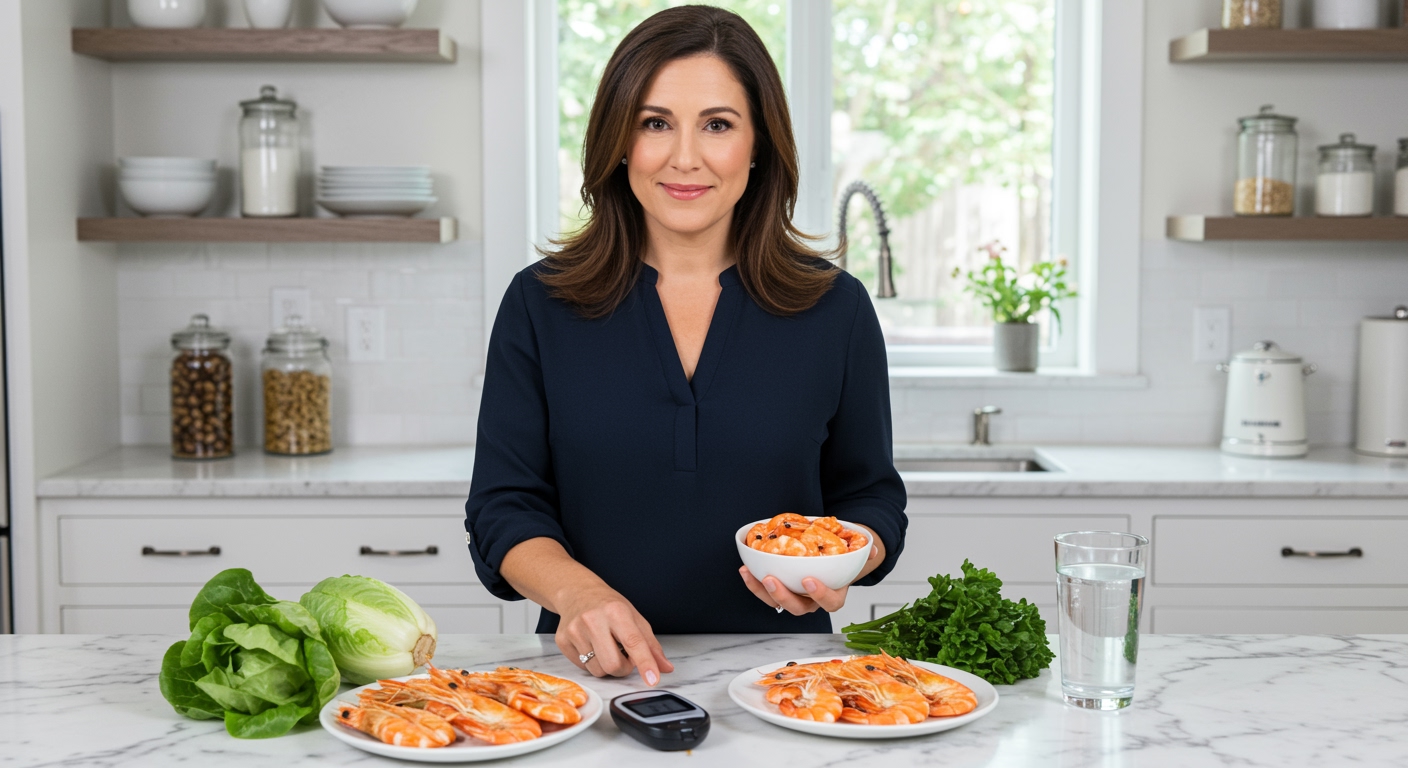✪ Key Takeaway: Shrimp is excellent for diabetes as it contains zero carbs, high protein, and helps stabilize blood sugar levels.
Introduction
Your doctor just told you that you have diabetes, and suddenly every food choice feels like walking through a minefield.
You might be wondering if your favorite seafood dishes are now off the table forever, especially that delicious shrimp you love so much.
Hi, I’m Abdur, your nutrition coach, and today I’m going to explain exactly why shrimp might be one of the best foods you can eat for diabetes management.
Does Shrimp Raise Blood Sugar Levels?
Shrimp contains zero carbohydrates, which means it has absolutely no direct impact on your blood glucose levels.
When you eat foods without carbs, your pancreas does not need to release insulin to process them.
This makes shrimp one of the most blood sugar friendly proteins you can choose.
The glycemic index of shrimp is zero because it contains no glucose-raising compounds.
Your body breaks down the protein in shrimp into amino acids, which are used for muscle repair and other essential functions rather than raising blood sugar.
This protein digestion process actually helps stabilize blood sugar by slowing down the absorption of any carbohydrates you might eat alongside the shrimp.
Research shows that high-protein foods like shrimp can even help improve insulin sensitivity over time when included as part of a balanced diet.
✪ Fact: A 3-ounce serving of shrimp contains 18 grams of protein and zero grams of carbohydrates.
What Makes Shrimp Beneficial For Diabetics?
Shrimp provides complete protein containing all nine essential amino acids your body cannot produce on its own.
This high-quality protein helps maintain muscle mass, which is crucial for people with diabetes because muscle tissue helps regulate blood sugar by acting as a glucose storage site.
The protein in shrimp also promotes satiety, helping you feel full longer and reducing cravings for high-carb snacks that can spike blood sugar.
Shrimp contains significant amounts of selenium, a mineral that acts as an antioxidant and may help protect against diabetic complications.
The omega-3 fatty acids in shrimp, though in smaller amounts than fatty fish, still provide anti-inflammatory benefits that can help reduce the chronic inflammation associated with diabetes.
Additionally, shrimp is naturally low in calories, with only about 84 calories per 3-ounce serving, making it perfect for weight management.
Maintaining a healthy weight is one of the most effective ways to improve blood sugar control and reduce diabetes complications.
✪ Pro Tip: Pair shrimp with non-starchy vegetables like broccoli or spinach for a perfectly balanced diabetic meal.
Are There Any Concerns With Eating Shrimp?
The main concern with shrimp for diabetics is not the shrimp itself, but rather how it is prepared and served.
Breaded and fried shrimp can contain significant amounts of refined carbohydrates and unhealthy fats that will spike blood sugar levels.
Sweet and sour shrimp dishes often contain high-sugar sauces that can cause rapid blood glucose spikes.
Shrimp is naturally high in cholesterol, containing about 166 milligrams per 3-ounce serving, but recent research shows that dietary cholesterol has less impact on blood cholesterol than previously thought.
However, people with diabetes already have increased cardiovascular risk, so it is wise to monitor your total cholesterol intake and discuss this with your healthcare provider.
Some people may also be concerned about sodium content, as shrimp naturally contains about 111 milligrams of sodium per serving.
While this is not excessive, those with both diabetes and high blood pressure should be mindful of their overall sodium consumption throughout the day.
✪ Note: Always choose grilled, steamed, or sautéed shrimp over breaded or heavily sauced preparations.
How Should Diabetics Prepare And Eat Shrimp?
The best cooking methods for shrimp include grilling, steaming, boiling, or sautéing with minimal added fats.
These preparation methods preserve the natural nutritional benefits while avoiding unnecessary carbohydrates and unhealthy fats.
Season your shrimp with herbs and spices like garlic, lemon juice, paprika, or fresh herbs rather than high-sodium marinades or sugary sauces.
A typical serving size for diabetics should be about 3-4 ounces of cooked shrimp, which provides adequate protein without excessive calories or cholesterol.
Combine shrimp with non-starchy vegetables like asparagus, bell peppers, zucchini, or leafy greens to create a complete, blood sugar-friendly meal.
If you want to include carbohydrates in your meal, choose complex carbs like quinoa or brown rice in controlled portions, keeping in mind your individual carbohydrate goals.
The fiber in vegetables and complex carbs will help slow digestion and prevent blood sugar spikes when eaten together with the protein-rich shrimp.
✪ Pro Tip: Try shrimp stir-fry with colorful vegetables cooked in a small amount of olive oil for maximum nutrition.
The Bottom Line
Shrimp is not only safe for people with diabetes but can actually be a valuable addition to a blood sugar management plan due to its zero carbohydrate content and high-quality protein.
The key to healthy eating with diabetes is not about eliminating foods, but about making smart choices and proper preparation methods.
I would love to hear about your favorite ways to prepare shrimp or any questions you might have about incorporating seafood into your diabetic meal plan, so please share your thoughts in the comments below.
References
At NutritionCrown, we use quality and credible sources to ensure our content is accurate and trustworthy. Below are the sources referenced in creating this article:
- Use Nourish: Can I Eat Shrimp With Diabetes
- January AI: Glycemic Index of Shrimp
- SugarFit: Is Prawns Good for Diabetes
- Klinio: Prawns and Diabetes





